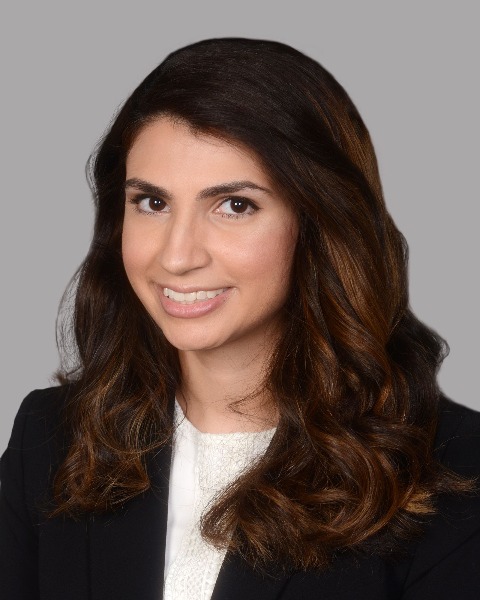Back
Poster Session C - Monday Afternoon
C0696 - Eosinophilic Gastritis: An Unusual Cause of Chest Pain and Dyspepsia
Monday, October 24, 2022
3:00 PM – 5:00 PM ET
Location: Crown Ballroom

Seema Mir, MD
University of South Alabama
Mobile, AL
Presenting Author(s)
Seema Mir, MD1, Mary Marshall, MD2
1University of South Alabama, Mobile, AL; 2University of South Alabama College of Medicine, Mobile, AL
Introduction: Eosinophilic gastrointestinal diseases (EGIDs) are chronic inflammatory diseases characterized by eosinophilic infiltration of the gastrointestinal tract without other known causes of eosinophilia. These are rare diseases which can affect patients of any age but typically present in the third through fifth decade. We present a case of a 30 year old female who presented with dyspepsia and chest discomfort who was found to have eosinophilic gastroenteritis.
Case Description/Methods: A 30 year old female presented to outpatient gastroenterology clinic after a recent ER visit for post-prandial chest discomfort with a negative cardiac workup. She reported a 1.5 year history of progressive dysphagia requiring regurgitation of solid foods, as well as epigastric pain and nausea. The patient was prescribed proton pump inhibitor therapy and scheduled for an esophagogastroduodenoscopy (EGD). Her EGD revealed an esophagus with linear furrows and exudate and diffuse hyperemic edematous gastric mucosa (Figure 1). Biopsies from both the esophageal and the gastric mucosa revealed elevated eosinophils. Peripheral eosinophils were measured and found to be elevated. Testing for other etiologies of eosinophilia, including inflammatory bowel disease and strongyloidiasis, were negative. The patient was started on steroids and had resolution of her symptoms. Repeat EGD showed no increase in eosinophils on biopsy. The patient was referred to allergy-immunology and had no improvement despite dietary modifications. While tapering steroids, she began having an increase in her previous symptoms along with flushing and hives. Given recurrence of symptoms, the patient was continued on the lowest dose of steroids tolerated and is transitioning to Dupilumab (Dupixent), an Interleukin-4 Receptor Antagonist.
Discussion: Clinical features of EGIDs vary and are related to the location, extent of organ involvement and layers of the GI tract with eosinophilic infiltration. Non-EoE EGIDs are rare, associated with allergic and atopic conditions, and typically affect female patients. Unlike EOE, other EGIDs do not have well defined diagnostic criteria or treatment algorithms. Management typically involves dietary therapy and glucocorticoids once other etiologies of esoinophilia have been evaluated. The pathogenesis of non-EoE EGIDs are not well known but thought to be similar to EOE. Dupixent was recently approved by the FDA as the first treatment for EOE but, to our knowledge, has not been studied in other EGIDs.

Disclosures:
Seema Mir, MD1, Mary Marshall, MD2. C0696 - Eosinophilic Gastritis: An Unusual Cause of Chest Pain and Dyspepsia, ACG 2022 Annual Scientific Meeting Abstracts. Charlotte, NC: American College of Gastroenterology.
1University of South Alabama, Mobile, AL; 2University of South Alabama College of Medicine, Mobile, AL
Introduction: Eosinophilic gastrointestinal diseases (EGIDs) are chronic inflammatory diseases characterized by eosinophilic infiltration of the gastrointestinal tract without other known causes of eosinophilia. These are rare diseases which can affect patients of any age but typically present in the third through fifth decade. We present a case of a 30 year old female who presented with dyspepsia and chest discomfort who was found to have eosinophilic gastroenteritis.
Case Description/Methods: A 30 year old female presented to outpatient gastroenterology clinic after a recent ER visit for post-prandial chest discomfort with a negative cardiac workup. She reported a 1.5 year history of progressive dysphagia requiring regurgitation of solid foods, as well as epigastric pain and nausea. The patient was prescribed proton pump inhibitor therapy and scheduled for an esophagogastroduodenoscopy (EGD). Her EGD revealed an esophagus with linear furrows and exudate and diffuse hyperemic edematous gastric mucosa (Figure 1). Biopsies from both the esophageal and the gastric mucosa revealed elevated eosinophils. Peripheral eosinophils were measured and found to be elevated. Testing for other etiologies of eosinophilia, including inflammatory bowel disease and strongyloidiasis, were negative. The patient was started on steroids and had resolution of her symptoms. Repeat EGD showed no increase in eosinophils on biopsy. The patient was referred to allergy-immunology and had no improvement despite dietary modifications. While tapering steroids, she began having an increase in her previous symptoms along with flushing and hives. Given recurrence of symptoms, the patient was continued on the lowest dose of steroids tolerated and is transitioning to Dupilumab (Dupixent), an Interleukin-4 Receptor Antagonist.
Discussion: Clinical features of EGIDs vary and are related to the location, extent of organ involvement and layers of the GI tract with eosinophilic infiltration. Non-EoE EGIDs are rare, associated with allergic and atopic conditions, and typically affect female patients. Unlike EOE, other EGIDs do not have well defined diagnostic criteria or treatment algorithms. Management typically involves dietary therapy and glucocorticoids once other etiologies of esoinophilia have been evaluated. The pathogenesis of non-EoE EGIDs are not well known but thought to be similar to EOE. Dupixent was recently approved by the FDA as the first treatment for EOE but, to our knowledge, has not been studied in other EGIDs.

Figure: Figure 1. EGD revealed an esophagus with linear furrows and exudate (A) and diffuse hyperemic edematous gastric mucosa (B).
Disclosures:
Seema Mir indicated no relevant financial relationships.
Mary Marshall indicated no relevant financial relationships.
Seema Mir, MD1, Mary Marshall, MD2. C0696 - Eosinophilic Gastritis: An Unusual Cause of Chest Pain and Dyspepsia, ACG 2022 Annual Scientific Meeting Abstracts. Charlotte, NC: American College of Gastroenterology.
